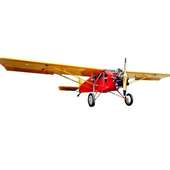- Being Scott Bessent (4/18/25)
- The FBI may be in your router (4/15/25)
- Instead of changing the rules, embrace the purpose of the game (4/11/25)
- Reading the signs and considering the future (4/10/25)
- Good Intentions, but at what cost? (4/4/25)
- Honoring Nebraska’s Vietnam Veterans (4/3/25)
- Keeping an eye out for “Humphrey’s Executor” (4/1/25)
Editorial
The limits of tariffs, then and now
Tuesday, April 8, 2025
As we endure the chaos, discomfort and insecurities associated with the administration’s current tariff negotiations, many Americans have begun to ask whether increased tariff revenues could help ease the burden of income taxes or even help pay down the national debt.
In short, the answer is a great big “no,” but it’s not a silly question.
There was, in fact, a time in American history when the federal government was funded almost entirely through tariffs and excise taxes. Before the Civil War, the United States had no permanent income tax. The bulk of the nation’s revenue came from customs duties collected at ports, with a relatively small group of high-value imported goods accounting for most of the income.
Textiles, iron goods, liquor, sugar, molasses, tea, coffee and luxury items like watches, carriages and fine china were all heavily taxed at the border. The taxes performed a double duty — raising funds for the federal treasury and protecting domestic industries from European competition. New York Harbor alone brought in more than half of all federal customs revenue by the mid-19th century.
Inland, excise taxes also played a role, levied on specific goods produced and consumed within the country. The most famous of these was the tax on distilled spirits, which triggered the 1791 Whiskey Rebellion when western Pennsylvania farmers rose up against what they saw as a tax that hit them harder than it did larger producers. Other excise taxes targeted items like tobacco, carriages, playing cards, medications and even bank checks. Some of these, like taxes on liquor and tobacco, remained reliable sources of federal revenue well into the 20th century.
But the world — and the federal government — has changed dramatically since then.
In today’s economy, tariffs are no longer a central pillar of national finance. In a strong year, total tariff revenue might reach $80 billion. That sounds impressive until one remembers that the federal budget is more than $6 trillion, and the national debt exceeds $34 trillion. Tariff revenue today covers barely more than 1% of what the government spends. It would take a near-total overhaul of modern American life — eliminating major programs like Social Security, Medicare, and military spending — to return to a tariff-funded model.
More importantly, we now operate in a deeply globalized economy. Most modern tariffs are not imposed to raise revenue but to serve as policy tools. They are used to correct trade imbalances, to protect strategic industries, and — in theory — to incentivize fairer trading relationships with countries like China or Mexico. They also come with consequences: higher consumer prices, disruptions in supply chains, and the risk of retaliatory tariffs on American exports.
Let’s be realistic about our expectations of the current tariff talks. They are not a magic wand for shrinking the deficit or eliminating the IRS. They are a negotiating effort to equalize trade relationships and, hopefully, to improve the terms under which American workers and industries compete on the global stage.
That’s a worthy goal, but it won’t turning the clock back to 1840.

